-
Latin America
Latin America
- Countries (hidden space)
- Galapagos & Ecuador
- Guatemala
- Mexico
- Panama
- Peru
- Popular Attractions
- Machu Picchu
- Inca Trail
- Easter Island
- Galapagos Islands
- Patagonia
- Rio de Janeiro
- Iguazu Falls
-
Africa
Africa
- Spacer Africa
- South Africa
- Zimbabwe
- Popular Attractions
- Cape Town
- Okavango Delta
- Sossusvlei Dunes
- Victoria Falls
- The Kruger
- The Garden Route
- Masai Mara
-
Asia
Asia
- Spacer Asia
- Laos
- Sri Lanka
- Uzbekistan
- Vietnam
- Popular Attractions
- Taj Mahal
- Lion Rock (Sigiriya)
- Angkor Wat
- Ha Long Bay
- Kyoto
- Europe & Middle East
-
Destinations
- Latin America
- Argentina
- Bolivia
- Brazil
- Chile
- Colombia
- Costa Rica
- Galapagos & Ecuador
- Guatemala
- Mexico
- Panama
- Peru
- Asia
- Borneo (Malaysia)
- Cambodia
- India
- Japan
- Laos
- Sri Lanka
- Uzbekistan
- Vietnam
- Middle East
- Jordan
- Southern & East Africa
- Botswana
- Kenya
- Namibia
- South Africa
- Zimbabwe
- Europe
- Slovenia
- All Holiday Destinations
- Contact Us
-
About
About
Llama Travel provides high quality holidays at the lowest possible prices.
99% recommend us Lower prices - guaranteed Financially protected by ATOL
The Llama Travel Blog
The 7 Best Markets in Latin America
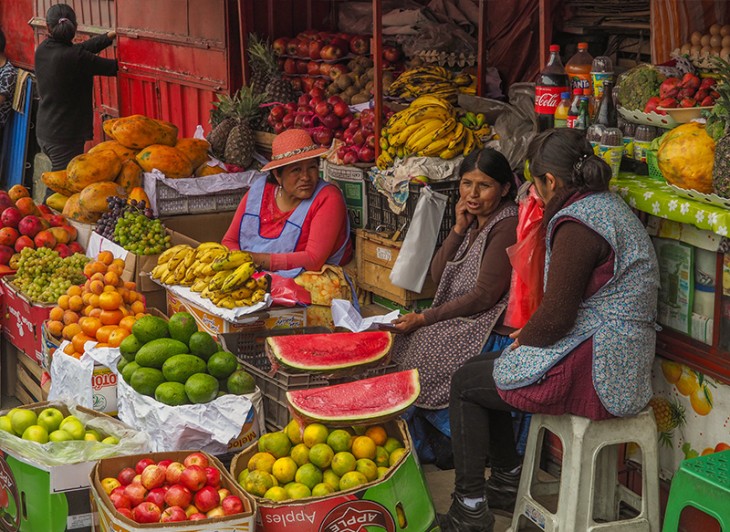
Renowned for its world-class textiles and artisan treasures, Latin America goes hand in hand with souvenir shopping. You’ll find markets of all shapes and sizes in most major cities, towns and even the most rural areas, serving as an important trading place for the locals. Piles of fruits and vegetables lining the pavements, vendors in traditional dress chanting their prices, craft stalls laiden with alpaca jumpers and colourful textiles, locals tucking into hearty soups and slow-roasted meats - these are all common sights throughout the continent. Instead of just passing through each place, by visiting a market you will be rewarded with a more authentic experience, knowing that you are helping with the development of a local community. With this in mind, we’ve put together a selection of some of our favourite markets in Latin America, plus some top tips.
1. Otavalo Market, Ecuador
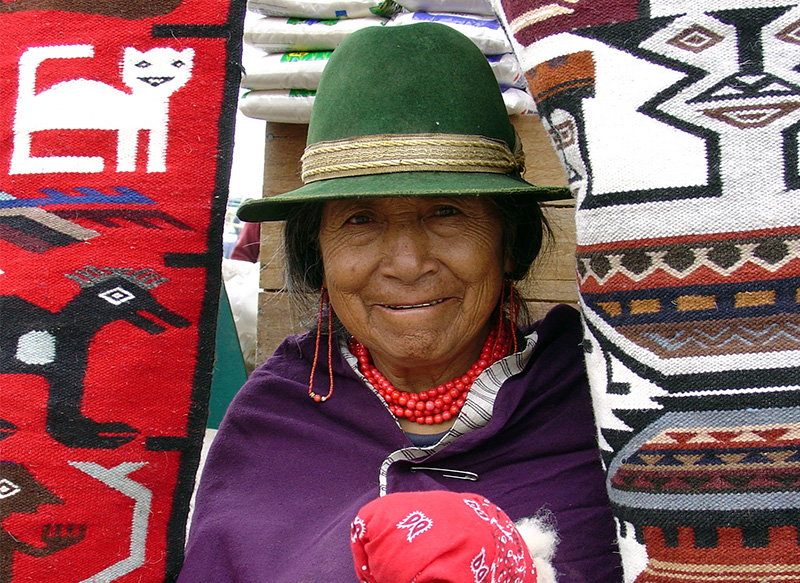
Perhaps the most famous market in South America, Otavalo is located in the Ecuadorian highlands, less than two hours north of Quito, Ecuador’s capital city. This is one of the most popular daytrips from Quito, particularly on Wednesdays and Saturdays, when thousands of indigenous locals descend to the main ‘Plaza de Ponchos’ square to sell their colourful wares. With a backdrop of the Andes and a number of excellent attractions nearby (a condor sanctuary, local instrument workshop, waterfall and crater lake to name a few), it’s definitely worth dedicating a day to. Endless souvenirs are sold at the market including panama hats, alpaca wool clothing, jewellery, textiles, ceramics, artwork, leather and more. There are also markets dedicated to food and animals.
Llama insight:
“Otavalo is definitely worth a visit, even if you don’t end up buying anything. The first time I found it quite overwhelming with the amount of vendors competing to sell you their produce, but once I got my bearings and realised they weren’t actually too pushy, as is often the case in markets, I loved it. To avoid being overwhelmed, it’s worth perusing the whole market first to scout out what’s on offer, before going back to your favourite stalls to do some haggling. Also, buy several items from the same stall and you'll get a great price. The drive from Quito to Otavalo is stunning, and there’s so much to see in the local area – you can visit Cuicocha, a volcanic crater lake, walk to Peguche waterfall and go behind the scenes at a workshop where they make Andean instruments. If you really don’t have time for Otavalo, however, there are a few places in Quito which sell similar produce on a smaller scale. Mercado Artesanal in La Mariscal neighbourhood has more than 200 stalls, selling a range of souvenirs including textiles, clothing, artwork, jewellery, ceramics and the like.” – Hannah, Llama Travel
2. La Paz Witches’ Market, Bolivia
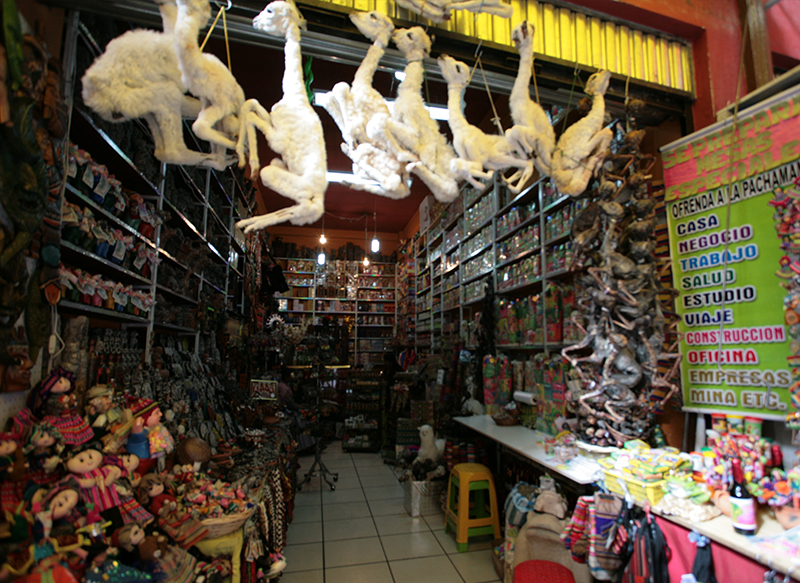
Probably the most unique on the list, the Witches' Market in La Paz is one of the Bolivian city’s main attractions. In this strange place you’ll find indigenous Aymara women wearing traditional bowler hats and colourful skirts selling weird and wonderful items which include charms, potions, herbs and even dried llama foetuses which often hang in the doorway. The market is set on cobbled, hilly streets in the centre of the city.
Llama insight:
“After visiting the Witches' Market, another great option in La Paz is Mercado Lanza, which is a great spot for a bite to eat or a refreshing juice. Each day we went to a local fruit vendor who would make us a juice based on any of the variety of fruit they overtly display on their stations, with all owners calling out for our business. The juice was always affordable, and they would top up our glass with what remained in the blender for free when you finished.” – Tsehai, Llama Travel
3. Pisac Market, Pisac, Peru
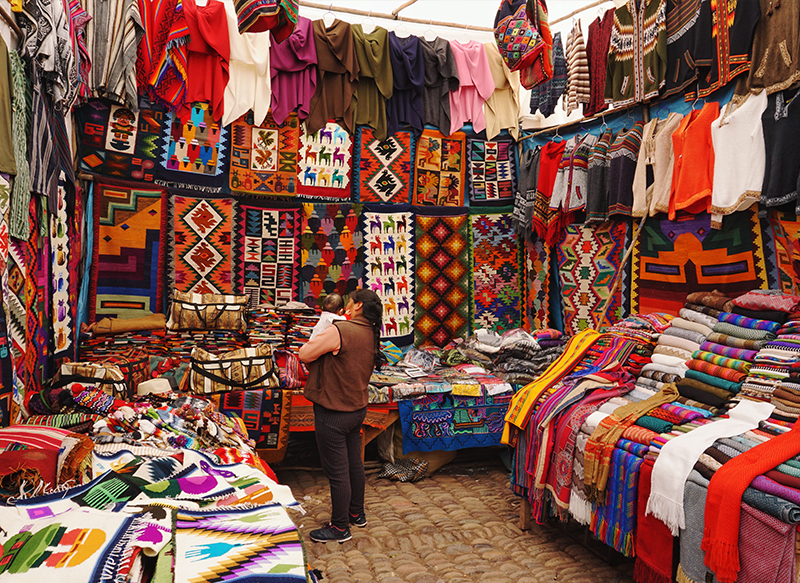
Pisac is a small market town popular with tourists as well as villagers from all around the Sacred Valley. The main attraction is the Inca site, situated above the town. There is also a crafts market which, like Otavalo in Ecuador, sees many vendors coming from far and wide to sell their products, often wearing the traditional dress from their village. Hundreds of stalls crowd the central square where the church is, though it also spills down the side streets. The market is an excellent place to try classic Peruvian dishes as well as haggle for handicrafts including a vast collection of hand-painted multi-coloured beads.
4. Chichicastenango Market, Guatemala
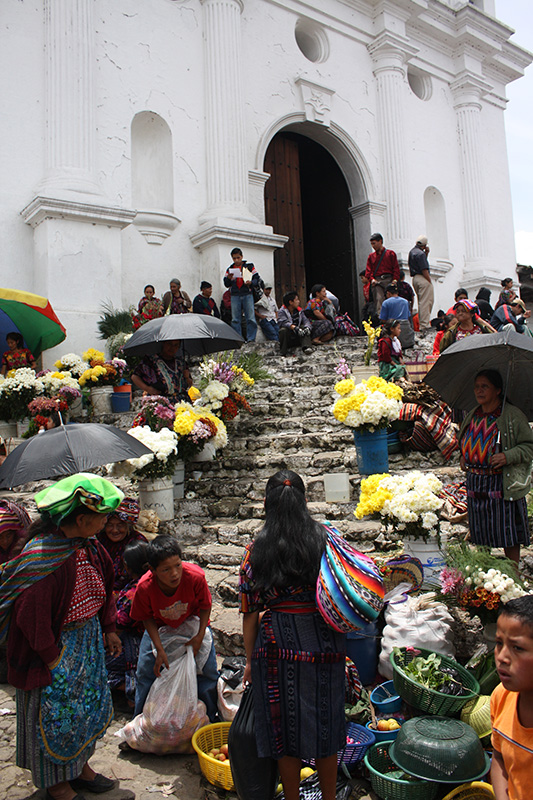
First things first, don’t worry about pronouncing the name correctly – the town is commonly known as ‘Chichi’. This is one of Central America’s most vibrant and engrossing markets. Locals sell a huge range of goods including flowers, handicrafts, textiles, fruits, vegetables and grains on the narrow cobbled streets and church steps. Twice a week, traders and weavers come from throughout the region to sell their produce to tourists and locals. You’ll notice that the locals wear traditional dress – women wear huipiles whilst men wear short trousers and black wool jackets, embroidered with silk.
Llama insight:
“Chichicastenango is exactly what I look for in a local market: not overly touristy, a dash of organised chaos, and a friendly feel - no one here will badger you relentlessly until you buy something. In three weeks of travelling, this was by far the most exciting place to purchase local products and souvenirs, and I found it entertaining even with souvenir shopping out of the way. Furthermore within the market we visited a church where a very unique situation has occurred: it is the only church where the Mayan beliefs have merged with Catholic practices and are depicted within the statues of the church. The story of this unique blend of beliefs adds yet another element to the experience of this fantastic market.” – Ollie, Llama Travel
5. San Pedro Market, Cusco, Peru
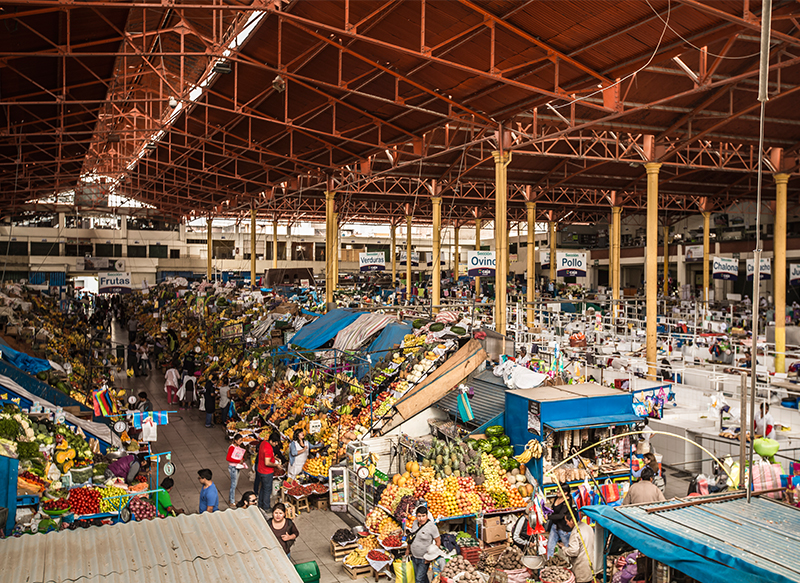
Cusco is an excellent place to buy crafts, with many excellent textiles and ceramics sold throughout the city. The San Pedro Market is a spectacle to behold, filled with colourful stalls selling everything from fruit, fresh smoothies, meat, pastries and vegetables through to local textiles and bags of coca leaves for those struggling with the altitude.
Llama insight:
“You can find everything and everyone in San Pedro Market. Set a few hours aside to wander slowly through the market, taking in the ‘Cusqueña’ culture and shopping around a bit instead of making impulse purchases. The juices are plentiful and delicious, but make sure you check that they’ve been made using bottled water before trying one. There are security guards dotted around the market, but the area inside is a little less secure so keep an eye on your wallets, cameras etc.” – Scott, Llama Travel
6. San Telmo Market, Buenos Aires, Argentina
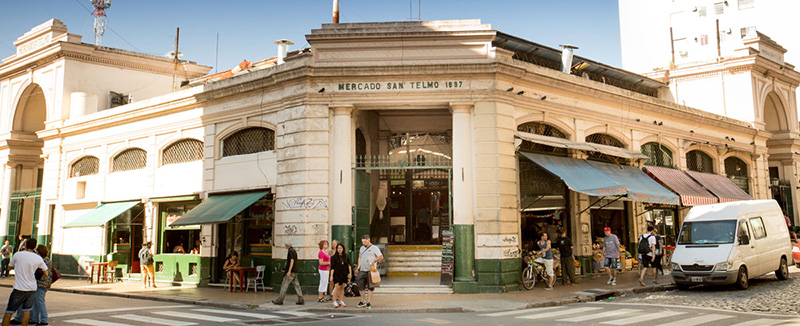
Known for its cobblestone streets and grandeur, San Telmo is a small neighbourhood in Buenos Aires, with an antique market that takes place every Sunday. It is quite easy to spend an afternoon in San Telmo wandering through its atmospheric streets, browsing the quirky shops, or even attending one of the free tango demonstrations which take place in the main square. A popular local pastime is to sit in one of the cafes with a cup of coffee or ‘mate’ (a much-loved tea in Argentina) and watch the world go by, whilst being entertained by tango street performers.
7. Saquisili Market, Avenue of Volcanoes, Ecuador
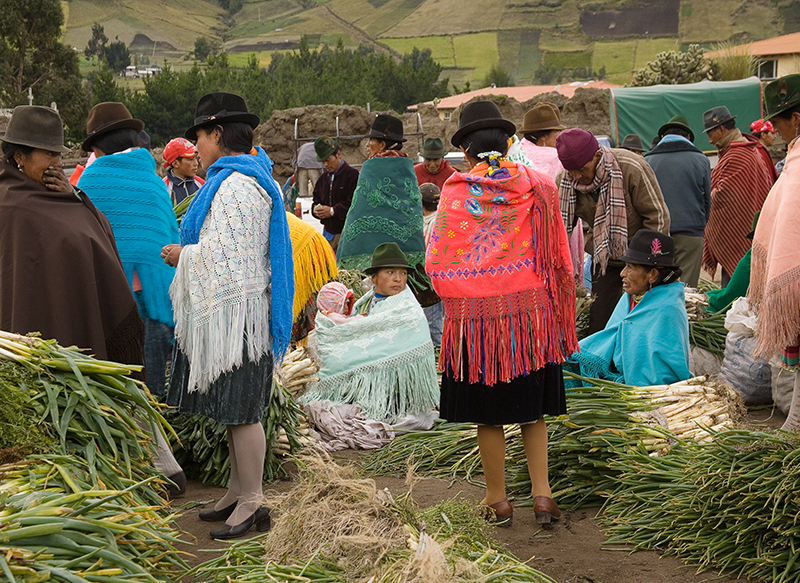
The towns in the central valley, forming Ecuador's Avenue of the Volcanoes, are famous for their markets. Probably the most important and colourful market in the valley, is the Thursday market in Saquisili, which has been around since pre-Columbian times. Whilst Otavalo has recently become more geared to tourists, this one is a great place to experience the local culture, with locals coming from the highlands to buy everything you can think of – pots and pans, herbal remedies, fruit and vegetables, livestock, textiles, furniture and more. There’s even a lively animal market early in the morning, when the streets are filled with the sounds of alpacas, sheep, cows, donkeys and pigs.
Llama insight:
“As well as Saquisili, an hour or so to the south of Quito is the town of Latacunga. Home to a bustling indigenous market, this is the place to see how rural Ecuadorians live. The market is a matter of function over form – it isn’t pretty, but its array of fruit, vegetables and grains is interesting and there is an authenticity there that you won’t find at just any market. Here the vendors and buyers alike dress in distinct clothing and have the dark hair and small stature common to many Andean communities.” – Catherine, Llama Travel
Top 10 tips for souvenir shopping in South America
- Bargain with respect. Ask your guide about accepted haggling standards, as this differs from country to country.
- Be aware of your belongings. Markets can have pickpockets, with tourists often appearing as attractive targets. To minimise the risk to yourself, do not walk around with expensive-looking jewellery or cameras around your neck, and leave passports and valuables in the hotel safe.
- Save some room in your suitcase! Even if you are not a shopaholic, you are bound to find some artwork, clothing or a bottle of Pisco with your name on it.
- Bear in mind the customs restrictions of where you are travelling to/from (alcohol, tobacco, food etc).
- Shop around before you buy. After browsing several stalls, you will realise that many of them sell similar items.
- Don’t be afraid to walk away and come back later if you’re still interested in an item.
- Buy multiple products from the same stall as this can often mean securing a better deal.
- Do not be fooled by street vendors who may try to scam you with low-quality overpriced goods. Be polite but firm.
- Avoid souvenirs made from animal parts, such as feathers. This often supports the killing of local wildlife, which goes against responsible travel.
- Take your own carrier bag with you, to avoid wasting plastic.
Buying from these markets not only lets you sample local produce and bring home memories of your trip, it’s also a great way of meeting the locals and contributing to the local economy, not to mention a happier relationship between them and us, the tourists.
If you would like any tips on planning your Latin American adventure, call us today on 020 7263 3000 or visit our website.
Found this blog useful? Sign up to our newsletter for more holiday tips and advice!
